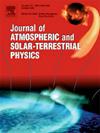热层中性质量密度的变率:多模式比较
IF 1.9
4区 地球科学
Q3 GEOCHEMISTRY & GEOPHYSICS
Journal of Atmospheric and Solar-Terrestrial Physics
Pub Date : 2025-09-12
DOI:10.1016/j.jastp.2025.106630
引用次数: 0
摘要
利用5种模式(MSIS2.0、HASDM、WACCM-X、TIEGCM和WAM-IPE)在不同地球物理条件下(地磁安静、中风暴和超级风暴)的输出,研究了低空/超低空热层中性质量密度的变化。选择这些模型来代表经验、同化和基于物理的方法。我们比较了5种模式在3个固定的LEO/VLEO高度(100、200和300 km)使用赤道和极地轨道的全球中性质量密度分布和密度的时间变化。分析的主要发现有:(1)模型结果存在显著的系统偏差;(2)超级风暴期间WACCM-X、TIEGCM和HASDM的峰值密度基本一致。然而,他们的UT差异高达半天;(3) WAM-IPE和MSIS-2.0模型给出的密度较其他模型低;(4)地磁活动对中性质量密度的影响随海拔高度增大而增大,在100 km高度可忽略,在150 km高度显著,在200 km高度显著;(5)地磁风暴会减小模型密度间的偏差,而模型间的系统偏差可能是由于模型所采用的参数化、驱动因素和边界条件不同造成的。需要使用多个和交叉校准的地面真值数据集对模型进行系统评估,以充分解决偏差并提供改进模型所需的洞察力。本文章由计算机程序翻译,如有差异,请以英文原文为准。
Variability in the thermospheric neutral mass density: A multiple model comparison
Variability in the thermospheric neutral mass density in LEO/VLEO altitudes has been investigated using outputs from five models (MSIS2.0, HASDM, WACCM-X, TIEGCM, and WAM-IPE) under different geophysical conditions: geomagnetically quiet, moderate storm and super storm. These models are selected to represent empirical, assimilation, and physics-based methods. We compared the global neutral mass density distribution and the time variations in the densities using equatorial and polar orbits at three fixed LEO/VLEO altitudes (100, 200, and 300 km) from the five models. Our key findings from the analyses are: (1) there are significant systematic biases among the model results; (2) WACCM-X, TIEGCM and HASDM peak densities are roughly consistent with each other during a super storm. However, their UT differences are up to a half day; (3) WAM-IPE and MSIS-2.0 models tend to give lower densities than other models; (4) the geomagnetic activity impact on neutral mass densities increases with altitude and it is negligible at 100 km altitude, becomes evident at 150 km, and is significant at 200 km; (5) geomagnetic storms tend to reduce the biases among the model densities The systematic biases among models are likely due to the different parameterizations, drivers and boundary conditions used in the models. A systematic evaluation of the models using multiple and cross-calibrated ground truth data sets is needed to fully address the biases and offer the insight required to improve the models.
求助全文
通过发布文献求助,成功后即可免费获取论文全文。
去求助
来源期刊

Journal of Atmospheric and Solar-Terrestrial Physics
地学-地球化学与地球物理
CiteScore
4.10
自引率
5.30%
发文量
95
审稿时长
6 months
期刊介绍:
The Journal of Atmospheric and Solar-Terrestrial Physics (JASTP) is an international journal concerned with the inter-disciplinary science of the Earth''s atmospheric and space environment, especially the highly varied and highly variable physical phenomena that occur in this natural laboratory and the processes that couple them.
The journal covers the physical processes operating in the troposphere, stratosphere, mesosphere, thermosphere, ionosphere, magnetosphere, the Sun, interplanetary medium, and heliosphere. Phenomena occurring in other "spheres", solar influences on climate, and supporting laboratory measurements are also considered. The journal deals especially with the coupling between the different regions.
Solar flares, coronal mass ejections, and other energetic events on the Sun create interesting and important perturbations in the near-Earth space environment. The physics of such "space weather" is central to the Journal of Atmospheric and Solar-Terrestrial Physics and the journal welcomes papers that lead in the direction of a predictive understanding of the coupled system. Regarding the upper atmosphere, the subjects of aeronomy, geomagnetism and geoelectricity, auroral phenomena, radio wave propagation, and plasma instabilities, are examples within the broad field of solar-terrestrial physics which emphasise the energy exchange between the solar wind, the magnetospheric and ionospheric plasmas, and the neutral gas. In the lower atmosphere, topics covered range from mesoscale to global scale dynamics, to atmospheric electricity, lightning and its effects, and to anthropogenic changes.
 求助内容:
求助内容: 应助结果提醒方式:
应助结果提醒方式:


